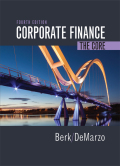
EBK CORPORATE FINANCE
4th Edition
ISBN: 8220103164535
Author: DeMarzo
Publisher: PEARSON
expand_more
expand_more
format_list_bulleted
Question
Chapter 19, Problem 3P
Summary Introduction
To determine: The projected interest payments and the amount of the projected interest tax shield.
Introduction:
The business plan is a necessary tool for the firm to analyze and take decisions on the current and future events. The firm must concentrate on the investments, capital structure, and operations to improve its potentials and future growth of the business.
Expert Solution & Answer
Want to see the full answer?
Check out a sample textbook solution
Students have asked these similar questions
6. Calculate the price of a
dividend paying stock
using the following
information, assuming the
price is equal to the present
value of all future dividends
one will receive from
owning the stock. (Hint:
treat the stock as a growing
perpetuity)
Dividend
$4.50
Growth rate
2%
Required return
12%
*
Finance question.
None
please listen if you deslike my answer i will give your also they change rule for sublitt.
Also if you will give more deslike bartleby site will be shut down.
Provide true solution.
Chapter 19 Solutions
EBK CORPORATE FINANCE
Ch. 19.1 - Prob. 1CCCh. 19.1 - Prob. 2CCCh. 19.2 - Prob. 1CCCh. 19.2 - Prob. 2CCCh. 19.3 - What is a pro forma income statement?Ch. 19.3 - Prob. 2CCCh. 19.4 - Prob. 1CCCh. 19.4 - Prob. 2CCCh. 19.5 - Prob. 1CCCh. 19.5 - Prob. 2CC
Ch. 19.6 - Prob. 1CCCh. 19.6 - Prob. 2CCCh. 19 - Prob. 1PCh. 19 - Prob. 2PCh. 19 - Prob. 3PCh. 19 - Prob. 4PCh. 19 - Under the assumptions that Idekos market share...Ch. 19 - Prob. 6PCh. 19 - Prob. 7PCh. 19 - Prob. 8PCh. 19 - Prob. 11PCh. 19 - Calculate Idekos unlevered cost of capital when...Ch. 19 - Using the information produced in the income...Ch. 19 - How does the assumption on future improvements in...Ch. 19 - Approximately what expected future long-run growth...Ch. 19 - Prob. 16P
Knowledge Booster
Learn more about
Need a deep-dive on the concept behind this application? Look no further. Learn more about this topic, finance and related others by exploring similar questions and additional content below.Similar questions
- Finance question. None please listen if you deslike my answer i will give your. Also if you will give more deslike bartleby site will be shut down.arrow_forwardFinance question. None please listen if you deslike my answer i will give your. Also if you will give more deslike bartleby site will be shut down.arrow_forwardCorrect solnarrow_forward
- Need soln for thisarrow_forwardMuskoka Tourism has announced a rights offer to raise $30 million for a new magazine, titled ‘Discover Muskoka’. The magazine will review potential articles after the author pays a nonrefundable reviewing fee of $5,000 per page. The stock currently sells for $52 per share and there are 3.9 million shares outstanding. Required What is the maximum possible subscription price? What is the minimum? If the subscription price is set at $46 per share, how many shares must be sold? How many rights will it take to buy one share? What is the ex-rights price? What is the value of a right?arrow_forwardNorthern Escapes Inc. has 225,000 shares of stock outstanding. Each share is worth $73, so the company’s market value of equity is $16,425,000. Suppose the firm issues 30,000 new shares at the following prices: $73, $69, and $60. What will the effect be of each of these alternative offering prices on the existing price per share?arrow_forward
arrow_back_ios
SEE MORE QUESTIONS
arrow_forward_ios
Recommended textbooks for you
 EBK CONTEMPORARY FINANCIAL MANAGEMENTFinanceISBN:9781337514835Author:MOYERPublisher:CENGAGE LEARNING - CONSIGNMENTPrinciples of Accounting Volume 2AccountingISBN:9781947172609Author:OpenStaxPublisher:OpenStax College
EBK CONTEMPORARY FINANCIAL MANAGEMENTFinanceISBN:9781337514835Author:MOYERPublisher:CENGAGE LEARNING - CONSIGNMENTPrinciples of Accounting Volume 2AccountingISBN:9781947172609Author:OpenStaxPublisher:OpenStax College

EBK CONTEMPORARY FINANCIAL MANAGEMENT
Finance
ISBN:9781337514835
Author:MOYER
Publisher:CENGAGE LEARNING - CONSIGNMENT

Principles of Accounting Volume 2
Accounting
ISBN:9781947172609
Author:OpenStax
Publisher:OpenStax College


Debits and credits explained; Author: The Finance Storyteller;https://www.youtube.com/watch?v=n-lCd3TZA8M;License: Standard Youtube License